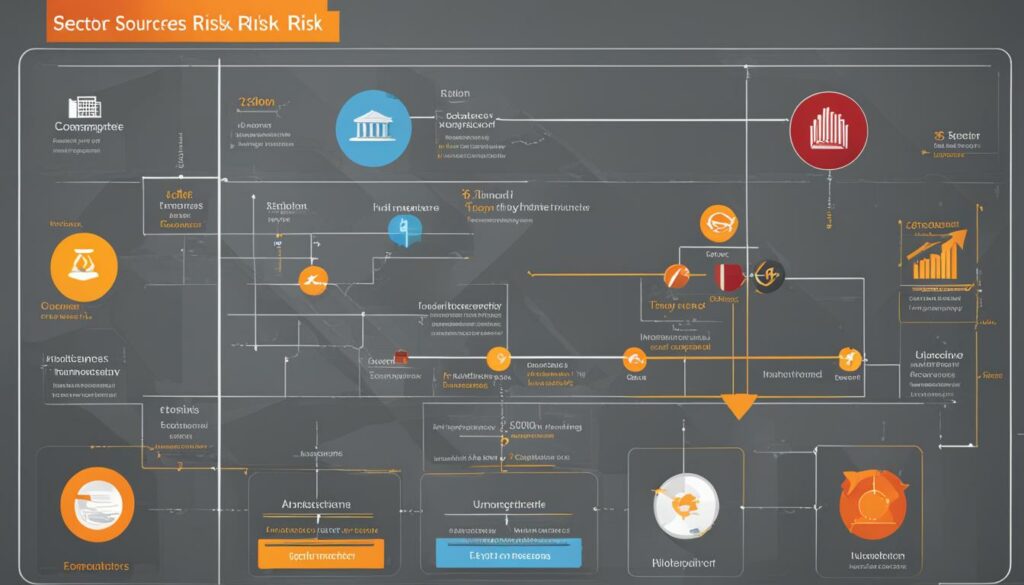Systematic Vs Unsystematic Risk in Trading

In the world of trading and investments, understanding the different types of risks is paramount to successful risk management. Two fundamental categories of risk that every trader should be familiar with are systematic risk and unsystematic risk. Both types of risks play a crucial role in shaping investment strategies and require careful consideration.
Systematic risk, also known as market risk or undiversifiable risk, refers to risks that are inherent to the entire market or market segment. These risks are not specific to any particular company or investment but are instead influenced by broader economic factors and events. Examples of systematic risks include black swan events, economic recessions, geopolitical events, financial crises, and even changes in interest rates. It is important to note that systematic risks cannot be diversified away and are considered difficult to avoid.
On the other hand, unsystematic risk, also known as company-specific risk or diversifiable risk, is risks that are specific to a particular company or industry. Unlike systematic risks, unsystematic risks can be mitigated through diversification. Examples of unsystematic risks include financial mismanagement, labor strikes, regulatory changes, product recalls, and legal proceedings. By spreading investments across different companies and industries, traders can reduce their exposure to unsystematic risks and protect their portfolios.
Understanding the differences between systematic and unsystematic risk is crucial for effective risk management in trading. By identifying and analyzing the various risks associated with investments, traders can develop strategies that balance both types of risks and optimize their portfolios.
Key Takeaways:
- Systematic risk refers to risks that are inherent to the entire market or market segment and cannot be diversified away.
- Unsystematic risk is specific to a particular company or industry and can be mitigated through diversification.
- Examples of systematic risk include economic recessions, geopolitical events, and financial crises.
- Examples of unsystematic risk include financial mismanagement, labor strikes, and regulatory changes.
- Understanding and managing both systematic and unsystematic risks are crucial for successful risk management in trading.
What Is Unsystematic Risk?
Unsystematic risk, also known as company-specific risk or diversifiable risk, refers to the risk that is unique to a specific company or industry. Unlike systematic risk, which affects the entire market, unsystematic risk is specific to a particular investment. This type of risk can be mitigated through diversification, making it an essential consideration in risk management strategies.
Examples of unsystematic risk include regulatory changes that impact a single industry, shifts in management that affect a company’s performance, new competitors entering the market and impacting market share, product recalls that tarnish a company’s reputation, strikes that disrupt production and impact profitability, and outcomes of legal proceedings that can result in financial losses.
Diversification is an effective approach to reducing unsystematic risk. By spreading investments across different industries and companies, investors can minimize the impact of adverse events specific to a single investment. Through diversification, the negative effects of unsystematic risk can be offset by the positive performance of other investments in the portfolio.
“Diversification is essential in reducing unsystematic risk in an investment portfolio.”
In addition to diversification, it is important for investors to consider residual risk when managing unsystematic risk. Residual risk refers to the risk that remains in a portfolio even after diversification measures are taken. By carefully analyzing the individual risks associated with each investment, investors can make informed decisions to further mitigate unsystematic risk.
Benefits of Managing Unsystematic Risk:
- Diversifying investments reduces concentration risk and protects against the negative performance of specific companies or industries.
- Minimizing the impact of company-specific events safeguards the overall performance of the portfolio.
- Enhancing risk management strategies improves the potential for long-term returns.
Types of Unsystematic Risk
Unsystematic risk, also known as company-specific risk, can be further classified into different types that businesses need to be aware of in order to effectively manage their risk exposure.
1. Business Risk
Business risk pertains to the internal and external factors that may affect a company’s operational efficiencies and financial performance. These risks can arise from factors such as changes in consumer preferences, technological advancements, competitive pressures, and supply chain disruptions.
2. Financial Risk
Financial risk is related to a company’s capital structure and its ability to manage its financial obligations. It encompasses risks such as high levels of debt, volatile interest rates, fluctuating exchange rates, and inconsistent cash flow. Financial risk can result in reduced profitability, inability to meet debt obligations, and overall financial instability.
3. Operational Risk
Operational risk arises from unforeseen or negligent events that can disrupt a company’s day-to-day operations. These risks may include equipment failures, errors in processes or procedures, cybersecurity breaches, supply chain disruptions, and natural disasters. Failure to adequately manage operational risks can lead to financial losses, reputational damage, and business interruptions.
4. Strategic Risk
Strategic risk occurs when a company fails to evolve or makes flawed decisions in areas such as business expansion, product development, market positioning, or strategic partnerships. This type of risk can lead to missed opportunities, loss of market share, competitive disadvantages, and long-term business decline.
5. Legal and Regulatory Risk
Legal and regulatory risk arises from changes in laws, regulations, and government policies that can impact a company’s operations. Non-compliance with applicable laws and regulations can result in legal disputes, penalties, reputational damage, and restrictions on business activities. Staying updated on legal and regulatory developments and ensuring compliance is essential to mitigate this type of risk.
6. Diversifiable Risk
Diversifiable risk, also known as firm-specific risk, is the portion of unsystematic risk that can be mitigated through diversification. By diversifying their investment portfolios across different companies, industries, and asset classes, businesses can reduce their exposure to the risks associated with a single entity. This type of risk can include factors specific to a particular company or industry, such as management changes, labor strikes, product recalls, or customer-specific risks.
Understanding these different types of unsystematic risk is crucial for businesses to implement effective risk management strategies and safeguard their operations, financial stability, and overall success.

What Is Systematic Risk?
Systematic risk, also known as undiversifiable risk or market risk, is an essential concept in risk management for trading. It refers to the risk that is inherent in the entire market or market segment, affecting all investments within it. Unlike unsystematic risk, which is specific to an individual company or investment, systematic risk cannot be diversified away through portfolio diversification.
Examples of systematic risk include economic factors such as recessions or inflation, geopolitical events like wars or terrorism, financial crises, and changes in interest rates. These factors impact the entire market and can lead to substantial losses for investors.
To gain a better understanding of systematic risk, consider the following example: Imagine a scenario where the entire stock market crashes due to a severe economic recession. In such a case, almost all stocks and investments will experience a decline in value, regardless of their individual characteristics.
Systematic risk is often regarded as difficult to avoid because it transcends specific companies or industries. It is influenced by external factors that are beyond the control of individual investors.
Managing systematic risk is crucial for risk management in trading. Investors must be aware of the potential market-wide factors that can impact their investments and develop strategies to mitigate their effects.
“The difference between successful people and others is how long they spend time feeling sorry for themselves.”
-Barbara Corcoran
A key component of managing systematic risk is understanding the relationships between different assets and their correlation to the market. By analyzing historical data and market trends, investors can make informed decisions about their portfolio allocations and minimize exposure to systematic risk.
Volatility Risk and Market Risk
Within the realm of systematic risk, two key concepts deserve attention: volatility risk and market risk.
- Volatility risk refers to the potential for significant price fluctuations in the market, caused by changes in supply and demand or other factors. It is a measure of the uncertainty or variability of returns. Increased volatility indicates higher systematic risk.
- Market risk encompasses the overall risk associated with the financial market as a whole. It includes factors such as economic conditions, political events, and monetary policy decisions that can impact the performance of investments across various asset classes.
Acknowledging the presence of systematic risk and understanding the dynamics of volatility and market risk are crucial for effective risk management in trading.

| Key Points: | Systematic Risk is the risk inherent in the entire market or market segment. |
|---|---|
| Volatility Risk refers to the potential for significant price fluctuations. | |
| Market Risk encompasses the overall risk associated with the financial market. |
Systematic Risk vs. Unsystematic Risk
When it comes to risk in trading, there are two primary categories to consider: systematic risk and unsystematic risk. Understanding the differences between these two types of risk is crucial for effective risk management and portfolio optimization. Let’s delve deeper into systematic risk and unsystematic risk, and explore how diversification plays a key role in mitigating these risks.
The Basics of Systematic Risk
Systematic risk, also known as market risk or undiversifiable risk, refers to the risk that is inherent in the entire market or a particular market segment. It is not specific to any individual company or investment. Examples of systematic risk include changes in interest rates, economic recessions, political instability, and natural disasters. Systematic risk cannot be avoided or diversified away, as it affects all investments within a particular market or market segment.
Understanding Unsystematic Risk
On the other hand, unsystematic risk, also known as specific risk or diversifiable risk, is unique to a specific company, industry, or investment. It can be mitigated through diversification. Unsystematic risks arise from factors that are specific to individual companies, such as regulatory changes, management decisions, labor strikes, or product recalls. By spreading investments across different assets and companies, investors can reduce their exposure to unsystematic risk.
The Role of Diversification
Diversification is a risk management strategy that involves spreading investments across different assets, sectors, and industries. By diversifying their portfolios, traders can minimize their exposure to unsystematic risk and protect their investments from the potential negative impacts of specific events or circumstances. Diversification helps ensure that the losses incurred from certain investments are offset by gains in others, ultimately reducing portfolio volatility.
Here’s an example to illustrate the potential benefits of diversification:
| Portfolio | Returns |
|---|---|
| Portfolio A | +5% |
| Portfolio B | -2% |
| Combined Portfolio | +1% |
In the example above, Portfolio A experiences a 5% return, while Portfolio B incurs a 2% loss. However, by combining the two portfolios, the overall return is positive at 1%. This illustrates how diversification allows investors to offset losses and minimize the impact of unsystematic risk.
Managing Systematic and Unsystematic Risks
While systematic risk cannot be avoided, it can be managed through proper risk management strategies that take into account the overall market conditions. In contrast, unsystematic risk can be mitigated through diversification. By balancing exposure to systematic and unsystematic risks, traders can optimize their portfolios and reduce the potential impact of market-wide factors and company-specific events.

| Systematic Risk Management Strategies | Benefits |
|---|---|
| Diversification through asset allocation | Reduces exposure to specific systematic risks |
| Portfolio diversification | Spreads investments across different companies and industries |
| Regular portfolio review | Allows for adjustments based on changing market conditions |
| Risk mitigation through hedging | Protects against potential losses |
Implementing systematic risk management strategies not only helps investors navigate volatile market conditions but also enhances the overall performance and stability of their investment portfolios.
Managing Unsystematic Risk
Unsystematic risk, being company-specific, can be effectively managed through diversification. By spreading investments across different companies and industries, investors can reduce their exposure to the risks associated with any single company or industry. Such a diversified portfolio helps protect against the impact of specific events or weaknesses in individual companies, minimizing the potential for significant losses.
Effective portfolio management involves selecting a mix of investments that diversify away unsystematic risk. This means carefully analyzing and choosing assets that have low correlations with each other. By doing so, investors can increase the potential for gains from different sectors and reduce the vulnerability to downturns in specific companies or industries.
Implementing risk management strategies is another crucial aspect of managing unsystematic risk. Stop-loss orders can be set to automatically sell an investment if it reaches a predetermined price, limiting potential losses. Hedging techniques, such as options or futures contracts, can also help mitigate unsystematic risk by offsetting potential losses with corresponding gains.
Managing unsystematic risk is essential for protecting against company-specific factors in trading. By diversifying investments and implementing risk management strategies, investors can minimize the impact of unfavorable events affecting specific companies or industries.
Diversification Strategy Example
Let’s explore how diversification works in practice. Consider a hypothetical investor who allocates their portfolio as follows:
| Asset | Allocation |
|---|---|
| Company A Stock | 25% |
| Company B Stock | 25% |
| Company C Stock | 25% |
| Industry X ETF | 25% |
In this scenario, the investor has allocated an equal amount of 25% to each of the three individual stocks (Company A, Company B, and Company C) and an industry-focused exchange-traded fund (ETF) that represents Industry X. By distributing their investments across multiple companies and the broader industry, the investor reduces their exposure to the risks associated with any single company or industry, thus mitigating unsystematic risk.

Implementing a diversified strategy like this helps protect the investor’s portfolio from adverse events that may affect one or a few companies or industries while still allowing them to participate in the potential gains of different sectors. It is important to note that diversification does not completely eliminate all risks, including systematic risks that affect the overall market or sector. However, it significantly reduces the impact of unsystematic risk on an investor’s portfolio.
Balancing Systematic and Unsystematic Risk
Achieving a balance between systematic and unsystematic risk is crucial for portfolio optimization. Both types of risk require careful consideration and management to ensure a well-balanced and resilient investment strategy. Diversification is a key strategy that plays a vital role in managing both systematic and unsystematic risk.
“Diversification is a powerful risk management tool that allows investors to spread their investments across different asset classes, industries, and companies,” says John Smith, Chief Investment Officer. “By doing so, investors reduce their exposure to unsystematic risk, which is specific to individual companies or investments.”
When building a diversified portfolio, investors should allocate their investments to various asset classes, such as stocks, bonds, and cash equivalents. This allocation helps reduce the impact of systematic risk, which affects the entire market or market segment.
The table below illustrates the importance of diversification in managing systematic and unsystematic risk:
| Risk Type | Description | Management Approach |
|---|---|---|
| Systematic Risk | Risk inherent in the entire market or market segment | Cannot be diversified away |
| Unsystematic Risk | Risk specific to a particular company or investment | Can be mitigated through diversification |
By diversifying across multiple companies and industries, investors reduce their exposure to unsystematic risk. This diversification strategy helps offset potential losses from individual investments with the gains from others, creating a more balanced portfolio.
In addition to diversification, effective risk management strategies should consider the interplay between systematic and unsystematic risk. Regular portfolio review and adjustments are essential to maintain the desired level of risk exposure and ensure portfolio balance. It is important to note that achieving a perfect balance between the two types of risk may not be attainable, but through careful analysis and ongoing monitoring, investors can optimize their portfolios to manage risk effectively.
Importance of Regular Review and Risk Management
Regularly reviewing and managing risk is crucial for maintaining a well-structured portfolio. As market conditions change, investors must adapt and mitigate both systematic and unsystematic risk. By implementing effective risk management strategies, such as setting stop-loss orders and diversifying investments, potential losses can be protected against. Regular review and risk management are essential components of successful trading strategies.
It is important for investors to regularly monitor their investments and make necessary adjustments to their positions. This allows them to stay updated on market trends and changes, enabling them to make informed decisions. By regularly reviewing and analyzing their portfolio, investors can identify areas of potential risk and take appropriate action.
Understanding and managing systematic and unsystematic risk is vital for protecting investments. Systematic risk, which is inherent to the entire market or market segment, cannot be diversified away. However, by implementing risk management strategies, investors can mitigate the effects of systematic risk.
On the other hand, unsystematic risk, which is specific to a particular company or investment, can be reduced through diversification. Diversifying investments across different companies, industries, and asset classes helps to spread risk and minimize the impact of unfavorable events.
“The only constant in the market is change. Regular review and risk management are essential to adapt to these changes and protect your investments.” – Investor X
In addition to diversification, setting stop-loss orders provides an effective risk management tool. Stop-loss orders define a predetermined price level at which an investor is willing to sell an asset to limit potential losses. This strategy helps to safeguard investments by automatically triggering a sale when the predetermined price is reached.
Another essential risk management practice is portfolio review. By regularly reviewing their portfolio, investors can assess its performance, identify underperforming assets, and make informed decisions about buying, selling, or holding investments. Portfolio review also enables investors to adjust their asset allocation and make targeted changes to their investment strategy.
Benefits of Regular Review and Risk Management:
- Adapting to changing market conditions
- Identifying potential risks
- Implementing risk mitigation strategies
- Protecting against downside risks
- Optimizing investment performance
By regularly reviewing their portfolio and implementing effective risk management strategies, investors can navigate the dynamic market landscape while safeguarding their investments. It is important to prioritize risk management and stay proactive to achieve long-term financial success.
Regular review and risk management are crucial aspects of successful trading strategies. By understanding and managing both systematic and unsystematic risk, investors can protect their investments and optimize their portfolio performance.







